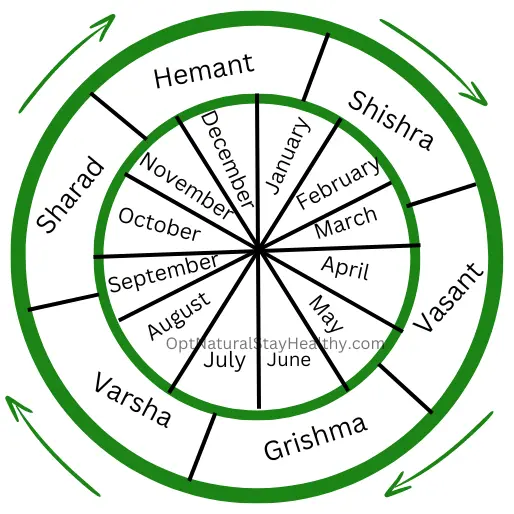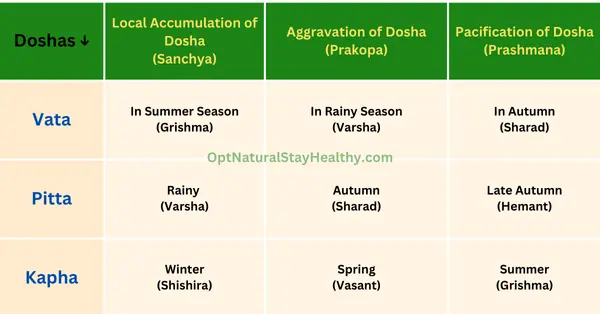Unlike the popular 4 seasons, there are six seasons in Ayurveda. We will understand the seasons w.r.t. Doshas (Vata, Pitta, and Kapha) in Ayurveda. Ritu is a Sanskrit word meaning season.
Doshas or Bio energies change during different seasons.
Ayurveda has depicted various rules and regimens (Charya), regarding diet and behaviour, to acclimate to seasonal changes easily without altering body homeostasis.[1]
Six seasons in brief
- Shishir Ritu (Winter) (Mid-January – Mid-March)
- Vasant Ritu (Spring) (Mid-March – Mid-May)
- Grishma Ritu (Summer) (Mid-May – Mid-July)
- Varsha Ritu (Rainy) (Mid-July – Mid-September)
- Sharad Ritu (Autumn) (Mid-September – Mid-November)
- Hemant Ritu (Late Autumn) (Mid-November – Mid-January)

Six Seasons in Ayurveda in detail
1. Shishira Ritu (Winter) (Mid January-Mid March)
- Winter increases vata
- Increases Kapha energy
- More strength in the body
- Good digestive power because agni, or digestive power increases in Winter
- Ayurveda recommends exercise and oil massage in winter
- You can eat heavy meals in the winter
2. Vasant Ritu (Spring) (Mid March-Mid May)
- Kapha increases and Pitta reduces
- The body has normal strength
- Weak digestion because the Agni, or digestive power reduces
- Kapha deposited in the winter melts with the heat and leads to many diseases
- Ayurveda recommends fasting in the Vansant or spring season.
3. Grishma Ritu (Summer) (Mid May-Mid July)
- Grishma season increases the Vata and pacifies the Kapha dosha.
- The body has less strength
- The digestion is mild due to mild digestive power or Agni
- Ayurveda recommends avoiding chilled water intake as it reduces the digestive fire.
4. Varsha Ritu (Rainy) (Mid July-Mid September)
- This season increases the vata and deposits the pitta.
- The body has weak strength and
- The weakest digestion is caused by the Agni, or the heavily dampened digestive power.
5. Sharad Ritu (Autumn) (Mid September-Mid November)
- Sharad or Autumn season increases the pitta dosha and pacifies the vata.
- The body has medium strength and strong digestion.
- Ayurveda recommends the intake of ghee and purgatory.
6. Hemant Ritu (Late Autumn) (Mid November-Mid January)
- This season pacifies the pitta
- Agni is the strongest this season, so the body has the strongest digestion.
- The body has the highest strength and energy this season compared to the other seasons.
Doshas and Seasons
The image depicts that Vata accumulates in the body in summer, gets unbalanced naturally in the rainy season, and gets pacified in autumn naturally. You can read for the Pitta and Kapha similarly in the image.

Ritucharya (Seasonal Regimen)
Ritu means season. Charya means Regimen or Discipline. Ritucharya means following a proper routine during each season.
The prime principle of the Ayurvedic system of medicine is the preventive aspect, which can be achieved by changes in diet and practices in response to changes in climatic conditions.[2]
Benefits of Ritucharya
- It helps to build physical strength
- It helps to balance the three doshas
- Boosts immunity
- It helps maintain good digestion
Ritucharya in Ayurveda in detail (each season)
1. Winter or Shishira Ritucharya
Recommended diet and lifestyle
- The meals must be sour, salty, heavy, thick, and unctuous- milk, cereals, ginger, garlic, sugarcane, and fermented foods.
- Oil application
- Warm places
- Sunbath
- Wear Warm clothes
- Wear oil on the scalp.
What to Avoid in Winter
- Exposure to cold
- Light cold food
- Staying up late at night
- Long-distance walks
2. Vasant Ritucharya (Spring Regimen)
Diet and Lifestyle
- Light diet
- Include Bitter, pungent, and astringent tastes in the diet
- Old barley, rice, and wheat are great options
- Honey water
- Warm water bath
- Gargle
- Emesis
- Nasal drops
- Exercise is a must during Vasant
What to Avoid in Spring
- Daytime naps
- Cold food
- Heavy Meals
- Sweet, sour, and salty
- Oily food
3. Grisma Ritucharya (Summer)
Diet and Lifestyle
- Light food (Lentils, moong khichadi, Green veggies, Indian gooseberry, water, buttermilk, and ghee)
- Cool places, sandalwood paste
- You can have daytime naps
What to Avoid in Summer
- Extreme exercise
- Salty and sour foods
- Hot spices
- Capsicum, black gram, and flat beans
4. Varsha Ritucharya (Monsoon season regimen)
Recommended diet and lifestyle
- Warm water bath
- Oil application or Abhyanga
- Medicated enema
- Dry medicated Powder application
- Consider food items like old barley, rice, wheat, honey, and salty taste.
What to Avoid in Monsoon
- Drinking rainwater
- Excessive fluids
- Meat
- Day naps
- Exercise
5. Sharad Ritucharya (Autumn Season Regimen)
Recommended diet and lifestyle
- Sweet food
- Sharp taste
- Rice, wheat, and green gram
- Medicated Ghee
- Exposure to the moon’s rays
What to Avoid in Autumn
- Hot bitter foods
- Oils
- Curd
- Excessive eating
- Day naps
- Exposure to winds and sunlight
- Eat only when you are hungry
6. Hemant Ritucharya (Late Autumn/Early winter)
Recommended Diet and Lifestyle
- Unctuous diet
- Sweet and salty food
- Exercising
- Body Massage
- Sun Bath
What to Avoid in Late Autumn
- Cold dry foods
- Cold drinks
- Day naps
- Exposure to winds
How to implement Ritucharya for yourself?
1. Plan
Prepare seasonal foods. Adjust your change in routine according to the season.
2. Observe your Body
You need to listen to your body and how it reacts to the season change and adjust accordingly.
3. Consult when in Doubt
If you are clueless about your body and Ritucharya in Ayurveda, it is a good idea to consult an Ayurveda practitioner or doctor.
4. Drink water
Have water according to the seasons and your body. Excess of everything is bad, and so is deficiency.
Conclusion
By changing our diet and lifestyle with the change of season, we can cultivate physical, mental, and emotional vitality. Ritucharya in Ayurveda is a broad concept that can keep you healthy effortlessly if followed rightly.
In Ayurveda, knowledge of Ritucharya is a first-hand guide to the concept of Kriya-Kala, which describes the modes and stages of disease development to the state of different Dosha – Vatu, Pitta, and Kapha – as time passes. A thorough understanding of it is critical for early diagnosis and prognosis in order to implement preventive and curative measures.[3]
Reference
Thakkar J, Chaudhari S, Sarkar PK. Ritucharya: Answer to the lifestyle disorders. Ayu [Internet]. 2011 Oct-Dec [cited 2025 Jul 8];32(4):466-471. Available from: Link to Study.
Jatinder Kumar. Ritucharya for a healthy life. J Ayurveda Integr Med Sci [Internet]. 2021May13 [cited 2025Jul.8];6(02):207 -211. Available from: Link to Study.
Swaroop Kumar, Sharma AK, Sharma KL, Meena R, Nigam A. Ritucharya – Prevention of Lifestyle Related Disorders. J Ayu Int Med Sci. 2023;8(1):118-125. Available from: Link to Study.





